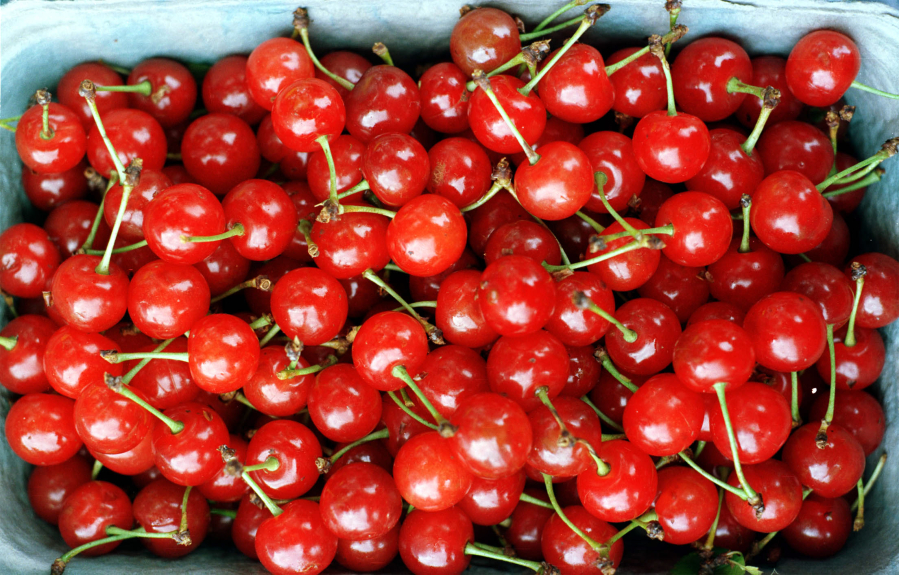Pie cherries are often called tart, sour, or red and are not as sweet as sweet cherry varieties. Pie cherries are great in pies, desserts, jams, jellies, salads, beverages, and main dishes. Pie cherry varieties such as Montmorency (most popular), morello and early Richmond can only be found fresh in local farmers’ markets, while sweet cherry varieties can be found most places produce is sold.
Pie cherries are extremely perishable and require rapid and careful handling from tree to consumer, with 99 percent of these pie cherry varieties frozen or canned within 48 hours of harvest. In 2015, Washington was the third-largest producer of pie cherries in the United States (24.5 million pounds).
When selecting fresh pie cherries, choose fully red fruit having a slightly soft, but not mushy, texture and with stems attached. Pie cherries are almost perfectly round in shape. The sugar content of these cherries increases toward the end of maturity, and their ripening stops once harvested. There should be no blemishes, cuts or bruising on the fruit. Vendor displays should be chilled or shaded for optimal fruit quality.
The fruit must be handled gently and carefully to prevent damage. Before eating, remove the stems and rinse under cool, running water.
If you don’t plan to use the cherries immediately, place cherries in a plastic bag, refrigerate as soon as possible, and enjoy within 3 days.
A quart of cherries can be pitted in 10 minutes using a hand crank cherry pitter. Alternatively, a straw can be used to push the pit out of the ripe fruit.
Pie cherries are juicier than sweet cherries, so when cooking with them you will want to use a thickener to thicken the liquids. These cherries will also need more sugar in the recipe than when using sweet cherries.
For future enjoyment, freezing is the preferred preservation method for retention of flavor, color and texture. Remove stems and gently wash under cool, running water; remove pits; place on a towel to dry, and then position — not touching one another — in a single layer on a sheet pan covered with parchment or waxed paper. Place sheet pan in freezer. Once frozen, transfer the individual fruit pieces into freezer appropriate containers for storage for up to a year. When needed, remove the amount of cherries needed from the container, leaving the remainder frozen.
There is also the option of canning the cherries or juice. For your and your family’s safety, always follow a recipe from a validated source. Refer to the resources below for recipes and more specific information.
Cherries can also be dehydrated and make an excellent snack on their own or included in a medley of dried fruits and nuts. Store packaged, dehydrated pie cherries in the freezer.
Some cherry preparation tips include:
• Add the cherries toward the end of your recipe preparation to optimize retention of texture and shape.
• Drain canned cherries (save the juice!) before using.
• Substitute a portion of the milk specified in a recipe with buttermilk or sour cream to help preserve the cherry color when using in baked goods. Additionally, frozen cherries should be partially thawed before inclusion in the mix.
For additional recipes, ideas, and serving suggestions, visit Chef Scotty on the WSU Master Food Preserver website below.
EQUIVALENTS:
1 pound fresh = 80 cherries = 2 1/2 cups pitted
1 pound fresh = 1 1/2 cups cherry juice
1 pie = 250 Cherries = 4 to 5 cups unpitted cherries
1 tree = 7,000 cherries = 28 pies
Leigh Rosenberger is a Clark County WSU Extension Master Food Preserver. For additional recipes, food preservation and food safety information visit http://ext100.wsu.edu/clark/?p=1134. Have questions? Call MFP Helpline: 360-397-6060 ext. 5366, or join Facebook Discussion Group “WSU Home Food Preservers – Clark County.”



